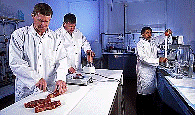United States Department of Agriculture: Agricultural Research Service, Lincoln, Nebraska

Roman L. Hruska U.S. Meat Animal Research Center: Reports
Date of this Version
1993
Document Type
Article
Abstract
Matching germplasm to resources through designed crossbreeding programs can contribute to optimum beef production efficiency. This is particularly true in light of the wide diversity of environmental conditions encountered by beef producers in the U.S. This approach requires considerable knowledge about genetic diversity among breeds in components of performance and furthermore how those components interact to influence life-cycle efficiency in the production setting. It was largely this identified need, coupled with the importation of a number of new breeds from continental Europe, that gave impetus for the establishment of the Germplasm Evaluation (GPE) Program. In Cycles I and II of the GPE program, increases in cow output associated with higher breed potential for growth rate and milk production were largely offset by equivalent or greater increases in feed requirements for maintenance and lactation. Additionally, in Cycle III, output of calf weaned per cow in the breeding herd was high for Bos indicus x Bos taurus crosses relative to Bos taurus crosses. More information is needed to evaluate F1 cross of Bos taurus versus Bos indicus x Bos taurus sources of germplasm. Therefore, this study was conducted to: 1) estimate input/output components, and 2) estimate life-cycle efficiency of Cycle III breeds representing these types of F1 cross females.


Comments
Published in Beef Research Program Progress Report (1993) No. 4 (Part 1): 55-56